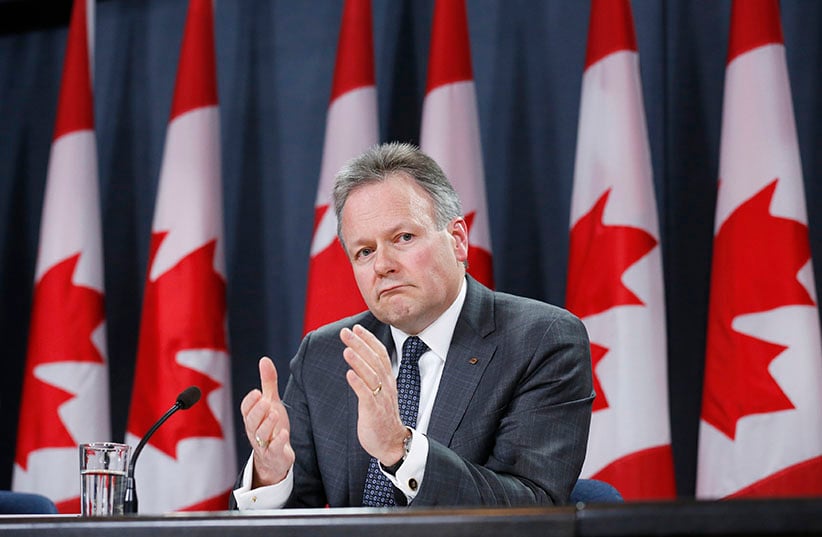Like everyone else, the Bank of Canada awaits the first Trudeau budget
The Bank offered a rare acknowledgement that a prospective spending push on infrastructure influenced its call
Bank of Canada Governor Stephen Poloz speaks during a news conference upon the release of the Monetary Policy Report in Ottawa January 22, 2014. Chris Wattie/Reuters
Share

This post was first published by Canadian Business.
The members of the Bank of Canada’s policy committee, like plenty of others, thought they were going to cut interest rates in January. “It is fair to say…that our deliberations began with a bias toward further monetary easing,” Governor Stephen Poloz said in his statement to the press at the end of those deliberations on January 20. Then they thought about it some more. The Governing Council ultimately opted to leave the benchmark interest rate unchanged at 0.5%. The decision suggests that Canada’s central bank thinks it has done all it can to boost the country’s flagging economy at this stage. Faster growth from here is a matter of time and how Prime Minister Justin Trudeau exercises his mandate to run deficits to build infrastructure.
The numbers argued for more stimulus. The international price of oil had dropped an additional US$20 per barrel since the Bank of Canada’s last economic outlook in October. The freefall appears to be at an end, but the time required to rebalance excess supply with weak global demand “will likely take longer than previously anticipated,” the central bank said in its updated Monetary Policy Report. Economic growth likely stalled in the fourth quarter. Therefore, it will take even longer to reach that magical point at which the economy is producing all it can without stirring inflation. The difference between that point and current production—the output gap—likely won’t close until sometime in 2017, according to the Bank of Canada’s new forecast.
Poloz and his deputies would have been tempted to make this difficult time a little easier on the men and women who have lost their jobs in Alberta, Saskatchewan and Newfoundland and Labrador. They see signs that Canada’s economy is adjusting to new areas of strength. The manufacturing and service and technology industries of Ontario and Quebec and British Columbia are doing relatively well. Those companies are getting a boost from a weaker dollar, and Canada is now a magnet for tourists.
But economies evolve, they don’t mutate. It will take several years for Ontario and Quebec to pick up the slack from the resource provinces. “While that adjustment process sounds mechanical, in fact, it is personal,” Poloz told reporters. “It is disrupting the lives of many Canadians, whether through job losses or through higher prices for imported goods. Monetary and fiscal policies can help to buffer some of these effects, and help speed up the process by fostering growth in other sectors of the economy, but the adjustment must ultimately take place.”
It is safe to assume that the Governing Council was privy to information that other forecasters didn’t have. Poloz indicated in his statement that the prospect of a big spending push by the federal government caused the committee to move away from its intention to cut interest rates. He insisted he didn’t know how much the Trudeau government was planning to spend. But Poloz and Finance Minister Bill Morneau would have talked. The head of the fiscal authority would have been able to tell the head of the monetary authority whether he was planning to go big, or whether he intended to be conservative. A betting person now would wager that Morneau is leaning toward the former.
Canada’s dollar was little changed after the decision, trading at around 68 U.S. cents. That’s about 30% lower than when Poloz took over as Bank of Canada governor in June 2013. Poloz indicated that the currency’s descent had become too quick for the governing council’s liking. Some economists worry about the effect of a weak dollar on consumer confidence. The central bank chief only talked about inflation. Non-energy exporters were getting a bigger boost from the exchange rate than the Bank of Canada expected in October, putting upward pressure on inflation, he said. There also was concern around the table about what a faster drop in value would do to inflation expectations. So far, the public has continued to trust that the Bank of Canada will keep prices advancing at its target of 2%. That makes a central bank’s job easier. “We must be mindful of the risk that a further rapid depreciation could push overall inflation higher relatively quickly,” Poloz said. “Even if this is temporary, it might influence inflation expectations.”
Many will have been surprised by the Bank of Canada’s decision. (I was.) Last year, Poloz was guided by the numbers in front of him, not theoretical concerns about the potential damage of lower interest rates. Something changed. Another year of ultralow interest rates is one consideration, as the central bank thinks Canada’s non-energy exporters are poised to do well as the global economy strengthens. The bigger shift is that the central bank no longer is in this alone. The departure of Stephen Harper and his obsession with balanced budgetsmeans monetary policy and fiscal policy finally will be working in concert. And that means the member of that duo who has been doing all the work to date finally can take a breather.